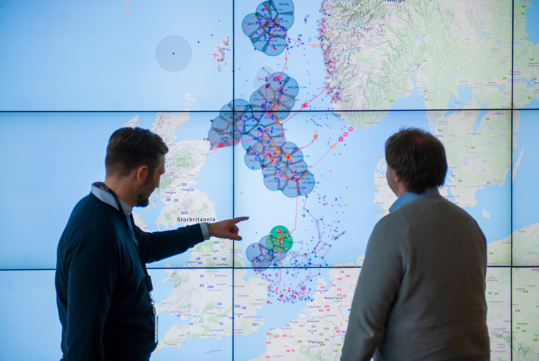


Partnering with the right management teams is important to ensure companies capture the full potential of a growth market, says 3i’s Oscar Tylegård
Several megatrends are impacting the digital infrastructure market, ranging from the increasing importance of data to sustainability and healthcare. But while these megatrends may appear enduring, this does not mean that incorporating them within investment portfolios will lead to easy returns. Deriving value when investing in digital infrastructure still depends on a selective approach and developing the right foundations for companies so that they can scale.
Oscar Tylegård, director at 3i, a multinational private equity and infrastructure firm, discusses the importance of getting the fundamentals right when acquiring and growing any digital infrastructure asset. Once you have a platform that is ready for growth, digital infrastructure can be a very attractive sector to be invested in.
Q) What approach should investors adopt when looking at digital infrastructure assets?
Oscar Tylegård: At 3i, we are not alone in keeping a close eye on megatrends, such as the energy transition and an ageing global population but digitalisation is one of the biggest megatrends affecting markets today. This has created a space that is proving attractive to many investors as it provides significant growth opportunities.
We take a slightly different approach by identifying targets and monitoring subsectors at the earliest possible stage. If you look across all our assets, we are not afraid to invest in niche businesses displaying better risk/reward potential. That is why we have backed companies such as Global Cloud Xchange, which owns one of the world’s largest private subsea fibre optic systems, and Tampnet, which provides fibre and digital connectivity services to the offshore energy industry.
In the digital space, there are many opportunities to set new strategies, where investors can do a lot of good work – as long as they are not afraid to explore new areas. For instance, we were early investors in the telecom tower space and this is now an area that has become very competitive. But that has also led us into other areas. It is all about finding the right opportunity that fits our investment mandate. Investors need to be open-minded but also possess a deep understanding of the many digital subsectors and markets.
Q) How can investment managers support the development of digital infrastructure companies beyond the asset acquisition
stage?
Oscar Tylegård: At 3i we see investment as a true partnership. It is essential that investors and management are aligned and agree on the best plan to deliver a company’s true potential.
This is the foundation from which we always begin. After a partnership has been established, we look to leverage our experience in the digital space. We have a track record in digital stretching back to the 1990s, so are good at pinpointing senior executives that we can bring in, either to management teams or at the board level, that can drive knowledge and expertise throughout an organisation.
We are not afraid to embrace opportunities with operational complexity. We can either make businesses more streamlined or take on a situation where there are multiple offerings and understand them deeply to help businesses decide on the right direction. Where we are most proud of our work is helping companies unlock situations that simply were not possible before. This has been the case with Tampnet, where we helped with the development of a fibre-led strategy in the Gulf of Mexico.

Tampnet: 3i unveiled a multi-million investment in a consortium with ATP to acquire the telecoms operator in 2018
Founded in 2001, Tampnet operates the world’s largest offshore high-capacity communication network in the North Sea and the Gulf of Mexico.
In 2018, 3i Infrastructure announced a €220 million investment in a consortium with Danish pension fund ATP, with each party acquiring 45 percent of Tampnet.
Key milestones during 3i’s ownership include the acquisition of a 1,200km fibre network in the Gulf of Mexico, the entering of the offshore wind market in the North Sea and the US, and the establishment of a new business unit to address the growing carbon capture and storage market. Regarding the company’s environmental ambitions, Tampnet is prioritising ways to enable oil and gas producers to extract more sustainably from their existing resources.
Q) What are some of the challenges you face when developing digital infrastructure projects?
Oscar Tylegård: On paper, you might have a very attractive opportunity but if you have not created the right fundamentals within an organisation, it becomes difficult to scale in the market. When we acquire a company, the first step is going back to basics. Do we have all the foundations in place to allow the company to grow? This includes many factors, such as the systems, people, decision-making capability and capital structure. This is something that can be lost in the digital space, particularly when you look at the smaller end of the scale. This is certainly something that we have to remind ourselves of.
As you go through scaling a business, you must make sure you have the right structure in place. With digital especially, you cannot just launch into a massive growth plan without having the foundations set. I think the keyword for me is ‘scale.’ There are other important considerations currently, of course, including supply chain issues and macroeconomic challenges, but we would hope that these are, to some extent, temporary.
Q) Given the pace at which digital technology develops, how do you factor this in when taking a long-term view as an investor?
Oscar Tylegård: I think it is important to differentiate between the infrastructure asset itself and the technology that you place on top of it. It is crucial that investors think about these two things separately. It is fair to question how much we know today regarding what AI and 5G/6G will unlock. But I think we can all agree that these are positive trends.
The question becomes, how positive? How much will this drive the utilisation of your fibre network, your telecom tower or your data centre? This is a significant uncertainty that people are struggling with when attempting to build a longer-term plan for a company. But there is certainly a need to differentiate between technology and the digitalisation of society and the infrastructure itself.
In addition to the uncertainty that investors are having to grapple with, there are also macroeconomic challenges to manage. Underlying trends we are seeing around inflation and slower growth are set to continue. But when you are experiencing headwinds, many businesses search for operational efficiencies – and digital is a great way of facilitating those.
The issue of inflation is interesting because it has really tested business pricing power and market position. Companies need to be very thoughtful about how they manage this high-inflation environment. In terms of digital specifically, there will be subsectors where there is not a clear link between inflation and revenue. This presents a big pricing point question for investors.
Q) What role does sustainability play in digital infrastructure?
Oscar Tylegård: Sustainability is at the top of the agenda for everybody. Digital infrastructure is fundamental to delivering the data that can underpin sustainability insights. We aim to help facilitate more sustainable processes for people and organisations facing this great challenge. At a basic level, digital technologies are helping organisations to monitor and measure certain sustainability metrics. This will be increasingly important as reporting standards become more stringent. We are also really excited about being a real facilitator of change. This is clear from our work with Tampnet, which is playing a core role in the digitalisation of the offshore wind industry and carbon capture market.
Carbon capture storage is a space that is set to take off in Europe and the US. We believe it will lean quite heavily on digital from the very beginning.
This is a market that has experienced a rapid pace of development and we are excited to be part of it.
Oscar Tylegård
Q) Which digital trends do you think will impact future investment opportunities and what is your longer-term outlook for digital infrastructure?
Oscar Tylegård: There are several trends that are exciting, including 5G, carbon capture and AI but I think for us, it is always about going back to the fundamentals. There is no doubt that digital infrastructure represents a growth market but can we identify companies that have the right platform, in the right market, with the right management team? This will always trump investing in an area just because it offers attractive macro growth trends from the outside.
Investors need to understand the risks within a particular business model. We are not disregarding any space in the sector, but any investment needs to be asset specific. We accept there are positive megatrends but we are cautious not to just jump on the bandwagon. Finding the right opportunities depends on spending a lot of time with your management teams.
Looking long-term, the outlook feels positive but there is still so much we cannot be sure of. We know what applications and technologies that exist today and what this means for the usage of digital infrastructure, but we do not yet know the implications of the digital applications and technologies that are still to be developed.
We are seeing rapid innovation in this sector and that is the most exciting thing looking long-term. For example, everyone is now very focused on AI and how it will impact companies and societies, but it’s fair to say we did not see the development being this rapid only a year ago. What will come in the next five or 10 years is a question for investors to think long and hard about.